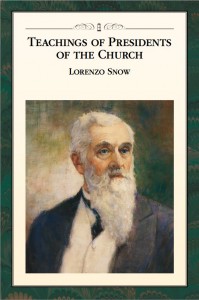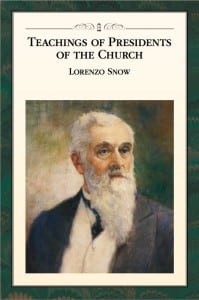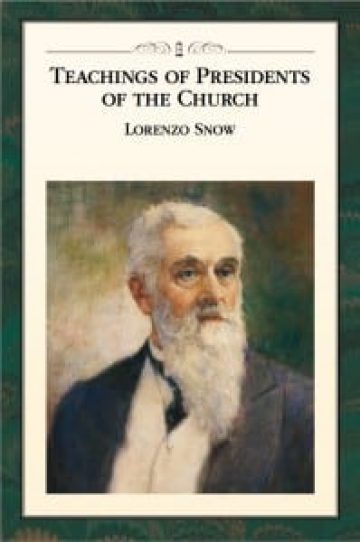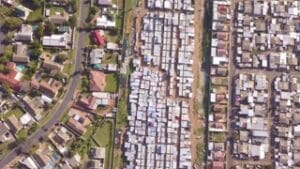 I love this lesson series. I love the different approaches different writers take, and the insights they have that I’d miss on my own. Most of all, I love that it exists. So of course the first place I went to prepare for teaching this lesson was EmilyCC’s post on the introduction to the Lorenzo Snow manual. She listed some great references, so I started reading.
I love this lesson series. I love the different approaches different writers take, and the insights they have that I’d miss on my own. Most of all, I love that it exists. So of course the first place I went to prepare for teaching this lesson was EmilyCC’s post on the introduction to the Lorenzo Snow manual. She listed some great references, so I started reading.
And I kept reading. And kept reading. Here’s the bottom line: Lorenzo Snow was fascinating. I had a great reaction from my lesson today, and even though I’ll bet you’ve all covered this part of the manual in your Relief Society lessons already, I want to share my notes just because I’m so in awe of the man. (Just please remember that they’re notes, and if you rudely point out grammatical or style errors I will send my peeps after you.)
What do we remember most about Lorenzo Snow? We probably know best what we saw in the Church movie about him: in the middle of a terrible drought in southern Utah, he told the people to be faithful in paying their tithing and the Lord would bless them with rain.
I think it’s interesting that the way stories are told changes our ideas of what they mean. Here’s a different perspective on Lorenzo Snow.
Lorenzo was born in Mantua, Ohio, but his two oldest sisters were born in Becket, Mass.
We know his family was wealthy. Family was very interested in reform religions – invited preachers into their home, etc. (They heard Joseph Smith preach in 1832.) This was the era of growing pains for the United States: there had been a revolution with a lot of new ideas about equality, but now people were figuring out what those revolutionary ideals meant for everyday people and a growing society. The Snow family lived not too far behind the frontier, and they were interested in a lot of the application of these ideas: abolition, people staking claims on land, an embracing of a new bumper crop of religions. They’re part of this group of people who are deciding by their everyday choices what America is. In a lot of cases they’re reformers. They’re building new things and new institutions and a new country. This is exciting!
And at least two members of the family are very, very bright: Lorenzo, and his sister Eliza, who’s ten years older. By the time Lorenzo was ready to pursue a collegiate education, Joseph Smith was living in Hiram, Ohio, four miles away. Eliza, another sister, and their mother joined the Church; Eliza moved to Kirtland, donated her entire inheritance to the Church, and began teaching school for Joseph Smith’s family.
Lorenzo chose to attend Oberlin College, about 65 miles west of his home in Mantua. Oberlin was and is a prototypical college town – the Oberlin Collegiate Institute opened in 1833, the same year the town came into being. The first class was 29 men and 15 women (women received diplomas from the “Ladies Course” until they were admitted to the baccalaureate program in 1837). It was progressive from the start, the brainchild of a Presbyterian minister and a missionary. It was the first co-educational college in the United States. There’s evidence that the school intended to be integrated from the beginning, though the first two African-American students didn’t enroll until 1835, the same year Lorenzo went. Ohio was one of the final stops on the Underground Railway and was particularly well racially integrated (still is); Oberlin was abolitionist, collectivist, and progressive, which may tell us something about Lorenzo. The founders of the college bragged that “Oberlin is peculiar in that which is good.”
On his way to college Lorenzo runs into Elder David W. Patten of the Quorum of the Twelve and is impressed despite himself – Patten is uneducated and “ungrammatical” but passionate about the faith. Snow finds himself interested: there’s something to Mormonism. He spends his year at Oberlin telling the other students about the new religion, but he isn’t a convert. It’s his dream to go to school at a prestigious Eastern university, but in the spring of 1836 Eliza convinces him to come to Kirtland to study Hebrew (the Church has organized this), and he joins the Church.
Lorenzo comes into the Church at just the right point here: he knows Joseph Smith, who’s conducting a revolution of his own: Mormonism. Lorenzo is dedicated to the cause and starts serving missions: Ohio, Missouri, Kentucky, Illinois, England (he comes back to Nauvoo with 250 English converts). He’s Joseph Smith’s campaign manager when he runs for President in 1844. He comes back to Nauvoo after Joseph’s death and finally embraces the Principle. Now a polygamist, he goes through the war of getting the Saints out of Nauvoo and safely to Salt Lake City. After he’s ordained an apostle, he ends up going back to Europe as a missionary: Italy, Switzerland, Malta, back to England to get the Book of Mormon published in Italian. Serves a mission in Hawaii. In 1872 and 1873 he goes with President George Albert Smith on a tour of Europe and the Middle East. Serves a mission to Native Americans in the northwest U.S. and Wyoming.
All the way through this he’s periodically teaching school, and periodically raising funds for Church interests: the Nauvoo temple, the Perpetual Emigrating Fund. So he’s good at teaching people and he’s good at raising money.
In the middle of this – 1853 – he’s called by Brigham Young to lead a struggling community in northern Utah. How does he do it? Twenty-five years later, he tells the Weber Stake:
Now, we are trying to do some thing in Brigham City in the direction to this order; but there seems to be the greatest difficulty with ourselves, when we come to these temporal affairs. Our old ideas of things have a wonderful influence over us, that it seems a difficult matter to break the crust, and conform wholly to the requirements of the United Order. We have arrived at certain points of union in our city; but I do not wish to speak about our affairs there in any spirit of boasting, for when I consider the sacredness of these principles, and the importance of them, I feel my insufficiency and unworthiness. To engage in this labor seems to be a great and sacred undertaking. President Young used to say, “Why, up there in Brigham City Brother Snow has led the people along, and got them into the United Order without their knowing it.” But I can see many things that we are very short of accomplishing. We have not entered into the fulness of the principles of the United Order, but we talk about them, and many of us try to conform to them, and get the spirit of them in our hearts. Now we number about three thousand souls, and we have moved along so far as this—I presume it is a little further than you have in Ogden—there is but one store in our city where imported goods are bought, and this belongs to the people. Now that is consider[ed] towards a union in a people of three thousand, to be agreed to do their trading in one place—that there should be one mercantile establishment. Now, you have more than one store in Ogden. Then, we have united a little further; we have but one tannery in our city of a population of three thousand. We have but one shoemakers’ establishment—an association of shoemakers, consisting of about thirty persons. There is no competition in this business. I suppose you have more than one in Ogden; but you are a greater people than we are, several times over. They all purchase their boots and shoes at this industrial department, and thus the men engaged in this business are sustained by the people, according to their covenants; and there are no other shoemakers in that locality. Well, we have united together on another point, that is, in a woolen factory and sheepherd. We met with a loss of some fifty thousand dollars in the burning of our factory, and the destruction of our crops by the grasshoppers. There are no rich people in Brigham City, but the people, through their union, have erected another building, much better than the one destroyed. We expect to have the factory in operation about the first of July. This shows some proof of the advancement of the people. This achievement is not in consequence of the people there having money; but this work—this amazing work, as I consider it—has been accomplished in consequence of the advancement that the people have made in this union. Well we have but one blacksmith shop in that city; Some twelve or fifteen work in this establishment, and the people sustain them in their operations. Those engaged in the various branches of labor feel confident that the people will patronize them, and carry out what they have agreed in this particular, and they do not trouble themselves about any other employment, or business. There is but one furniture shop in Brigham City, and the people sustain those engaged in that business. I suppose you have more than one. There is but one tin shop, and it is patronized by all the people of Brigham City. There is but one lumbering department there, and the people sustain the parties who are employed in that business. Some eighty or one hundred persons are engaged during the lumbering season. The mills are owned by the people, and there is no competition. There is but one millinery shop in that city, and it is sustained by the people. You have more than one here; perhaps you ought to have. There is but one tailor’s shop in Brigham City, and the people employed in that business are patronized by the whole people. I might mention a great many other businesses, but will leave that subject now.
Now, for the people in Ogden and the people in other settlements, it would be a good thing to unite together to supply themselves with their clothing, food, furniture, building materials, and with everything that pertains to their comfort and convenience, without being under the necessity of employing, or using, those things that are imported. You have a great many wide-awake, financeering men in Ogden, very intelligent men, who are full of wisdom and stir, and have the principles of the Gospel in them. You are ahead of the people of Brigham City in this respect, but we are ahead of you in some other respects. In proportion as a man possesses a knowledge over his brethren, we should be more anxious to accomplish good for Zion; and he should be the one to set a proper example for the union of the people. I believe if the Latter-day Saints would go forward and establish the United Order in their midst more than they do, the Lord would more abundantly sustain and bless us, and provide remedies against the evils to which we are exposed—persecution and difficulties from outside, that we will not talk about to-day (http://en.fairmormon.org/Journal_of_Discourses/19/48).
Lorenzo Snow gave his whole life to this cause. And I don’t think that he found it limiting. I don’t think he felt that he was giving up his education and moving to a godforsaken desert – I think he found this exciting. He was making Mormonism work. He’d been educated with African-Americans. He’d seen people oppressed. He was a leader of this community – I’m going to guess that he’d have been a leader of any community – and he was taking Joseph Smith’s ideals and the whole idealistic, passionate Mormon movement and finding ways for people to express that passion and idealism in everyday life. He was passionate about consecration. He took what he’d learned from Oberlin and was using it to build the Kingdom of God.
Let’s talk about polygamy for a moment. The Edmunds Act made polygamy illegal; Snow spent a year (1886 to 1887) in prison for practicing polygamy, after losing a federal case in the Supreme Court. He had five wives at this point. (In total, he ends up with nine – though not all simultaneously – and 42 children.) In 1887 the passage of the Edmunds-Tucker Act allows the federal government to seize any property owned by the Church that enables polygamy. The threat of anyone seizing temples had the Saints in an uproar. (By the way, there was never any real property seized. The Church was worth about $3 million, though heavily in debt, and though government agents seized about $400,000 in assets – later returned – they didn’t have the reach or manpower to take any real estate. But the Edmunds-Tucker Act wasn’t repealed until 1978, and a lot of Mormons still distrust the federal government.)
In 1890, President Wilford Woodruff publishes the Manifesto, declaring (in a wishy-washy manner) that the Church will no longer practice polygamy. Even though there is a unanimous vote in General Conference to sustain the Manifesto, for several years there is an ambiguity about polygamy: Okay, we’re going to obey the law in the United States. How about in Mexico? How about Canada? Do we abandon the plural marriages that already exist? And because there is a very real threat to seize Church property, people start to lose faith in the Church as a political and financial entity, and there’s no one committing their inheritance (that would be crazy!) and the Church falls further and further in debt.
Polygamy had been such a touchstone for the Church – an organizing focal point. In the interest of (and perhaps under the cover of) advocating for their people and their way of life, Mormon women became very active in the feminist movement, and were really among the most radical feminists of the time. They’d gotten the vote in 1870 and had it taken away in 1887 with the Edmunds-Tucker Act – you can imagine they weren’t happy about this.
When Wilford Woodruff dies in 1898, Lorenzo Snow inherits a church that is very divided about polygamy. The Twelve are divided. People are still being arrested and imprisoned. There are legal battles still to fight. The first thing he does – after the Lord appears to him in the Salt Lake temple – is to reorganize the First Presidency. Up to this point, Church leaders have waited two to three years, but he does it immediately. He’s been with the Church for over 60 years. He’s in his eighties.
The Church is heavily, heavily in debt at this point – and we’re talking about a church that has had financial problems and scandals from the very beginning. The Edmunds-Tucker Act had disincorporated both the Church and the Perpetual Emigrating Fund on the grounds that they promoted polygamy. In 1890 the church was worth about $3 million. Actual assets seized by the government were actually worth less than $400,000, and though the law (and the Supreme Court’s decision to uphold it) allowed for seizure of real property, it never actually happened. The legal battles contributed to the Church’s financial difficulties. So what does this highly intelligent, well-educated leader do?
The first thing he does is to issue a total of $1 million in short-term bonds. (The Church is worth $3 million and about $2.3 million in debt; he issues short-term bonds when he has about $700,000 in capital. You don’t have to be a financial genius to know that this is super, super risky.) And then he starts talking about tithing. If you’ve seen “The Windows of Heaven” – the movie about the drought in southern Utah and President Snow preaching that obedience to the law of tithing will bring rain? – you only know part of the story. Up to this point, people had given 10% of their assets to the Church upon conversion, and tithing was on annual increase. He essentially got rid of the initial on-conversion commitment and just asked members to pay their 10% tithing.
You can look at this in two ways. The first is that President Snow attempts to get the Church out of financial (and societal – remember, this is a church divided) trouble with a risky financial vehicle and lowering his expectations of the members.
The second way, though, and I think this is closer to what happened: Lorenzo Snow knew about living in communities. He knew about organizing societies from the ground up. He’d been in Oberlin, where he didn’t pay tuition because every student was expected to help build the town and the college while they were getting an education. (They’ve long since discontinued the practice, but the Oberlin motto is still “Labor and Learning.”) He was in Kirtland. He was in Nauvoo. He saw the Church fail financially over and over and over. He saw his sister commit her inheritance to the Church. He believed so wholeheartedly in the movement that he devoted his entire adult life to it. He’d heard Joseph Smith preach about Zion and the United Order and consecration, and he understood these things in a way that his predecessors in Church leadership didn’t – I think he really saw Joseph’s vision of this new social order, this new way of living in community. He managed Joseph Smith’s presidential campaign. He raised money for Church projects like the temple in Nauvoo and the Perpetual Emigrating Fund that were highly communal in nature. Joseph died before he could make communal living work practically; Brigham Young and John Taylor were English and just didn’t understand this new American way – and very Mormon ideal – of living in a community where the leaders are the common folk. (He did quote Brigham Young as saying, “Why, up there in Brigham City Brother Snow has led the people along, and got them into the United Order without their knowing it.” (http://en.fairmormon.org/Journal_of_Discourses/19/48)) Woodruff was dealing with polygamy and trying to get the Church or its people some legal standing in Washington (he was successful; Utah received statehood in 1896, but not in the way the Mormons had wanted). So Lorenzo Snow inherits this political firestorm and a financially-strapped, house-divided church. And in this stroke of absolute genius, absolute inspiration, combines Joseph’s vision of unity with what he’s learned from watching four Mormon leaders and what they’ve done with their inspiration, and he says, We need to be united, not divided. We can’t live polygamy, this part of divine law that helped keep us united, because we weren’t allowed to do so. Let’s commit to living another basic tenet of divine law – consecration – maybe not in the way Joseph preached it, because we’ve tried it and we’ve failed over and over. But let’s go back to the Old Testament law of the tenth and let’s live that one perfectly. And he gives the members something to rally around. The percentage of members paying any tithing at all hovers around 15% throughout the 1890s, but after the first year of Snow’s presidency that number jumps to 26%, and many more of them are full tithes: paying tithes becomes a rallying point for members. The Church pays off its last debts in 1907.
We Mormons are known for our financial savvy, but the testimony I have of this story has nothing to do with sound fiscal management or smart financial dealings. It’s a testimony of the miracle of community, of the importance of equality and teamwork, of the very solemn and necessary thing it is to commit one’s self to a greater cause and not turn back.
References:
Teachings of Presidents of the Church: Lorenzo Snow. (https://www.lds.org/bc/content/shared/content/english/pdf/language-materials/36787_eng.pdf?lang=eng)
Presidents of the Church Student Manual Religion 345. (http://www.ldsces.org/inst_manuals/presidents%20of%20church/Chapters/ChurchPresStdnt32480000_07.pdf)
Presidents of the Church Teacher Manual Religion 345. (http://www.lds.org/manual/presidents-of-the-church-teacher-manual-religion-345/lorenzo-snow-fifth-president-of-the-church?lang=eng)
D. Michael Quinn, “Summary: The History of Tithing.” (http://lds-church-history.blogspot.com/2010/12/lds-history-summary.html)
Journal of Discourses. (http://en.fairmormon.org/Journal_of_Discourses)
“About Oberlin: History.” (http://new.oberlin.edu/about/history.dot)
Jill Mulvay Derr, Janath Russell Cannon, and Maureen Ursenbach Beecher, Women of Covenant: The Story of Relief Society.
S. George Ellsworth, “Utah’s Road to Statehood.” (http://archives.utah.gov/research/exhibits/Statehood/intronew.htm)






7 Responses
So interesting, Libby! Thanks for posting your notes. I had no idea about so much of this.
I wish I could have been in the room while you taught this…I love reading your passion infused into this story!
Libby, I want you to move to my ward and be my RS teacher. (You can go ahead and stay where you are for a few more years, though. I was recently called to Primary so it will be awhile before I attend RS again, anyway.)
Love this, Libby! Adds such depth to the man and what he was about!
I love this too, because I love context and I love stories.
[…] Well, goodness. What had President Snow spent all that time teaching about? It turns out that while the above statement is technically true, it leaves out the fact that as an apostle, Lorenzo Snow spoke frequently and emphatically about the law of consecration, known to early Mormons as the United Order. In fact, before joining the Church, he studied for a year at Oberlin College, where students labored to build and maintain the college and town in lieu of paying tuition–another great experiment in American collectivism, and certainly an experience he used as he helped build the community of Brigham City, Utah. (If you’d like to dig into the background a little more, you can find my notes on “The Life and Ministry of Lorenzo Snow” here.) […]
[…] been studying Lorenzo Snow in Relief Society and Priesthood classes. Lorenzo Snow was educated at progressive Oberlin College, the first coeducational college in the United States of America and served as president of the […]